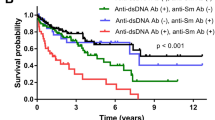Abstract
Antinuclear antibodies (ANAs) are a serological hallmark of systemic autoimmune rheumatic diseases (SARDs); however, few studies have investigated their post-treatment levels. The mechanism by which ANA titers are upregulated in SARDs remains unclear. We assessed factors associated with the ANA titer after treatment. In this retrospective study, we analyzed the clinical database of Zhongshan Hospital, Medical College of Xiamen. Demographic data and baseline and 12-month post-treatment ANA titers were collected. Bivariate and multivariate analyses were performed to determine the factors associated with the ANA titer. This study identified 31,923 patients who underwent ANA assay for SARDs screening, and a total of 1043 patients were included in the study. Approximately 16% of the patients showed a decrease in the serological ANA titer. Younger patients (< 20) were 3 × more likely to experience such a decrease (P = 0.005) compared to older patients (≥ 60 years). Having a baseline ANA titer > 1:10,000 was associated with an increase likelihood of a decrease in the serological ANA titer compared with baseline ANA titer 1:10,000, 1:3200 and 1:1000 (P < 0.001). We found that a decrease in the serum ANA titer at 12 months after treatment for SARDs is associated with age and ANA baseline titers.





Similar content being viewed by others
Data availability
All the data used to support the findings of this study are available from the corresponding author upon request.
References
Wang L, Wang FS, Gershwin ME. Human autoimmune diseases: a comprehensive update. J Intern Med. 2015;278(4):369–95.
Pisetsky DS. Antinuclear antibody testing—misunderstood or misbegotten? Nat Rev Rheumatol. 2017;13(8):495–502.
Damoiseaux JG, Tervaert JW. From ANA to ENA: how to proceed? Autoimmun Rev. 2006;5(1):10–7.
Abeles AM, Abeles M. The clinical utility of a positive antinuclear antibody test result. Am J Med. 2013;126(4):342–8.
Infantino M, et al. The clinical impact of Anti-DFS70 antibodies in undifferentiated connective tissue disease: case reports and a review of the literature. Immunol Res. 2017;65(1):293–5.
Sur LM, et al. Antinuclear antibodies: marker of diagnosis and evolution in autoimmune diseases. Lab Med. 2018;49(3):e62–73.
Lee AY, Hudspeth AR, Ray U. Evaluation of antinuclear antibody (ANA) in ANA-associated connective tissue diseases. J Clin Pathol. 2015;68(10):853–4.
Wei Q, et al. Analysis of antinuclear antibody titers and patterns by using HEp-2 and primate liver tissue substrate indirect immunofluorescence assay in patients with systemic autoimmune rheumatic diseases. J Clin Lab Anal. 2020;34(12):e23546.
Chan EK, et al. Report of the first international consensus on standardized nomenclature of antinuclear antibody HEp-2 cell patterns 2014–2015. Front Immunol. 2015;6:412.
Infantino M, et al. ANA testing in ‘real life.’ Ann Rheum Dis. 2020;79(1):e3.
Lee AY, Hudspeth AR, Adelstein S. The concordance of serial ANA tests in an Australian tertiary hospital pathology laboratory. Pathology. 2016;48(6):597–601.
Petri M, et al. Derivation and validation of the Systemic Lupus International Collaborating Clinics classification criteria for systemic lupus erythematosus. Arthritis Rheum. 2012;64(8):2677–86.
Aletaha D, et al. 2010 Rheumatoid arthritis classification criteria: an American College of Rheumatology/European League against Rheumatism collaborative initiative. Arthritis Rheum. 2010;62(9):2569–81.
Shiboski SC, et al. American College of Rheumatology classification criteria for Sjogren’s syndrome: a data-driven, expert consensus approach in the Sjogren’s International Collaborative Clinical Alliance cohort. Arthritis Care Res (Hoboken). 2012;64(4):475–87.
van den Hoogen F, et al. 2013 Classification criteria for systemic sclerosis: an American College of Rheumatology/European League against Rheumatism collaborative initiative. Arthritis Rheum. 2013;65(11):2737–47.
Sharp GC, et al. Mixed connective tissue disease—an apparently distinct rheumatic disease syndrome associated with a specific antibody to an extractable nuclear antigen (ENA). Am J Med. 1972;52(2):148–59.
Wijeyesinghe U, Russell AS. Outcome of high titer antinuclear antibody positivity in individuals without connective tissue disease: a 10-year follow-up. Clin Rheumatol. 2008;27(11):1399–402.
Fritzler MJ. Choosing wisely: review and commentary on anti-nuclear antibody (ANA) testing. Autoimmun Rev. 2016;15(3):272–80.
Kurzinski KL, Zigler CK, Torok KS. Prediction of disease relapse in a cohort of paediatric patients with localized scleroderma. Br J Dermatol. 2019;180(5):1183–9.
Suurmond J, et al. Loss of an IgG plasma cell checkpoint in patients with lupus. J Allergy Clin Immunol. 2019;143(4):1586–97.
Suurmond J, et al. Patterns of ANA+ B cells for SLE patient stratification. JCI Insight. 2019;4(9):e127885.
Suurmond J, Diamond B. Autoantibodies in systemic autoimmune diseases: specificity and pathogenicity. J Clin Invest. 2015;125(6):2194–202.
Nasiri S, et al. Correlation of ESR, C3, C4, anti-DNA and lupus activity based on British Isles Lupus Assessment Group Index in patients of rheumatology clinic. Rheumatol Int. 2010;30(12):1605–9.
Kang I, et al. Utility of age, gender, ANA titer and pattern as predictors of anti-ENA and -dsDNA antibodies. Clin Rheumatol. 2004;23(6):509–15.
Stohl W, et al. Elevated serum globulin gap as a highly reliable marker of elevated erythrocyte sedimentation rate in patients with systemic rheumatic diseases. Semin Arthritis Rheum. 2019;49(3):485–92.
Author information
Authors and Affiliations
Contributions
ZY-L, XY, and LY-Q conceived and designed the experiments. ZY and WJ-J performed the experiments. ZY-L and XY analyzed the data. LY-Q and WJ-J contributed reagents/materials/analysis tools. XY and ZY-L wrote the paper. XY and LY-Q critically revised the manuscript for intellectual content. All the authors have read and approved of the final manuscript.
Corresponding author
Ethics declarations
Conflict of interest
The authors declare that they have no competing financial interests.
Ethical approval
This study was approved by the Institutional Ethics Committee of Zhongshan Hospital, Medical College Xiamen University, and performed in compliance with national legislation and the Declaration of Helsinki guidelines.
Informed consent
Informed consent was obtained from all individual participants included in the study.
Additional information
Publisher's Note
Springer Nature remains neutral with regard to jurisdictional claims in published maps and institutional affiliations.
Rights and permissions
About this article
Cite this article
Xiao, Y., Lin, Y., Zhang, Y. et al. Factors associated with the antinuclear antibody (ANA) titer of systemic autoimmune rheumatic diseases in ANA-positive patients after treatment: a retrospective study. Clin Exp Med 22, 439–446 (2022). https://doi.org/10.1007/s10238-021-00759-z
Received:
Accepted:
Published:
Issue Date:
DOI: https://doi.org/10.1007/s10238-021-00759-z



